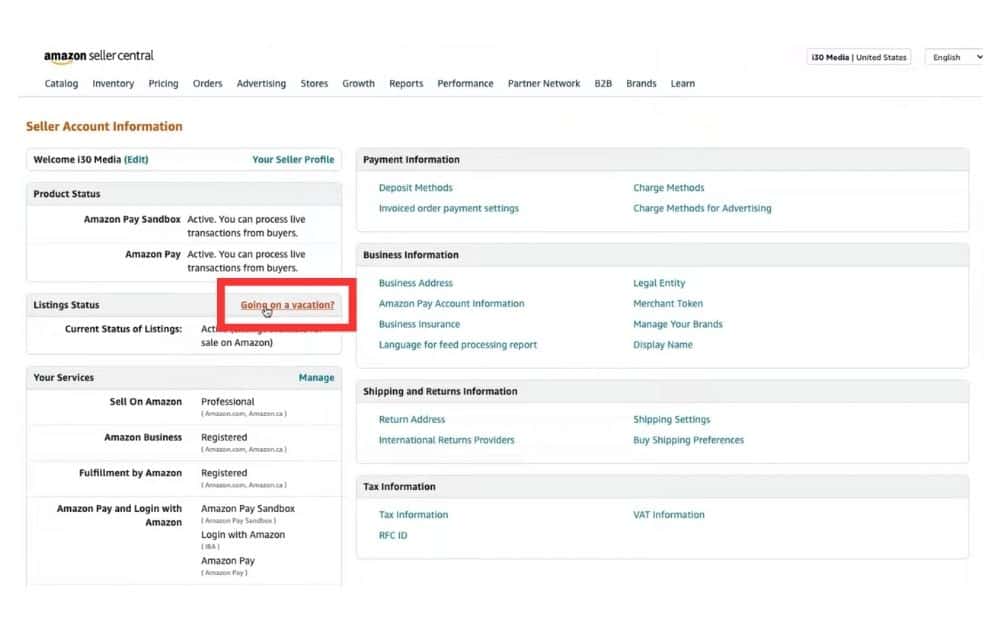Wouldn’t you like to enjoy a vacation without worrying about your store performance? Then you’ll be happy to know that there’s an Amazon seller vacation mode, which will allow you to take a breather.
Let’s delve into the ins and outs of this service, equipping you with the knowledge and strategies needed to step away from your online store confidently.
What Does Vacation Mode Mean in Amazon Seller Central?
Whether you’re planning a short getaway or an extended hiatus, mastering how to set vacation mode on Amazon can provide you with peace of mind and the opportunity to recharge. And while you do so, you can still maintain a strong presence on Amazon.
But can you really put your Amazon seller account on vacation mode? Technically, you can’t find the exact term “Amazon seller vacation mode” on Seller Central. However, you can use the Vacation Settings to set your store to active or inactive.
There are two primary ways to use Amazon Seller Central vacation mode, depending on the type of seller account you have.
1. Fulfillment By Merchant (FBM)
If you’re an FBM seller, you can use the Amazon seller vacation mode to deactivate your listings manually. However, you’ll have to plan ahead because it’s not an instant process.
In some cases, you may expect a waiting period of up to 48 hours before Amazon deactivates your listings.
What happens if you go on a holiday without waiting for your Amazon seller vacation mode to take effect? Well, you risk the chance of receiving orders that you won’t be able to fulfill on time.
This situation is not ideal because it could negatively affect your performance metrics. In addition, customers who don’t receive their items within the expected timeframe might also give you poor reviews, ultimately harming your store’s reputation.
2. Fulfilled by Amazon (FBA)
Does vacation mode affect FBA? The quick answer is no.
If you’re an FBA seller, you have the option to keep your listings active even while on vacation. After all, Amazon takes on the responsibility of storing your inventory as well as picking, packing, and shipping orders.
The marketplace also handles customer returns and customer service inquiries related to shipping and fulfillment. This means that even when you’re on vacation, Amazon’s fulfillment centers continue processing and shipping orders on your behalf.
However, it’s not ideal to go off the grid for a long time while your listings are active. Even if Amazon handles the fulfillment process, you might still need to address customer inquiries and issues to ensure a positive customer experience.
Additionally, you’ll need to manage your inventory to prevent stockouts or dead inventory while you’re on vacation.
So, how can FBA sellers take a break? You can do so by deactivating your Stock Keeping Units (SKUs) individually. This approach will let you exercise fine-grained control over your product listings.
How Does Amazon Vacation Mode Work?
Should you be unable to fulfill orders for various reasons, such as a family emergency, adverse weather conditions, or taking a holiday or vacation, you can set your Listings Status to Inactive.
According to the marketplace’s help guide, this Amazon seller vacation mode setting will remove your listings from Amazon’s product detail pages and search results within one hour.
Once you’re ready to resume selling, you can easily switch the status of your listings back to Active.
How to Turn On Vacation Mode on Amazon
Here is how to put Amazon on vacation mode:
- In Seller Central, navigate to the upper-right corner of the screen, where you can find Settings. Click on Account Info from the drop-down menu.
- Within the Seller Account Information page, locate the Listings Status section and select ‘Going on a vacation?’

- On the Vacation Settings page, you have the option to modify your settings for one or multiple marketplaces.

How to Turn Off Vacation Mode on Amazon
Here are the steps to turn off Amazon seller vacation mode and resume selling on the marketplace:
- On the Vacation Settings page in your Seller Central account, click the Active button.

- Wait for your listings to reactivate and become visible in search results in about an hour.
If you have any FBA listings, these will still be active on the marketplace.
Things to Do Before Turning on Amazon Seller Vacation Mode
Here are a few pointers before turning on Amazon vacation mode:
Plan Ahead
When you turn on vacation mode on Amazon Seller Central, there may be a delay in deactivating your listings. Amazon typically takes some time to remove your listings from product detail pages and search results.
This means that if you activate vacation settings too close to your departure date, your listings might still be active when you’re away, and you could receive orders that you won’t be able to fulfill.
To avoid this, plan ahead by activating vacation settings well in advance of your vacation or absence.
Fulfill Existing Orders
As an Amazon seller, you have a commitment to your customers to fulfill orders promptly. When a customer places an order, they trust that the product will be delivered within the estimated time frame.
Failure to fulfill orders can result in customer dissatisfaction, negative feedback, and potential damage to your reputation.
Ensure Efficient Communication
Prepare auto-response messages for buyer inquiries for the entire period you’ll have Amazon seller vacation mode on. You can set up these automated messages in your Amazon seller account to respond to customer inquiries while you’re away or temporarily unavailable.
This tool is crucial for maintaining communication with your customers, even when you’re not available to respond personally. It also ensures that users receive timely acknowledgment of their inquiries, which is essential for a positive shopping experience.
Appoint a Customer Service In-Charge
Having someone to handle customer service on your behalf while you’re on vacation is crucial to maintain business operations and ensure a positive customer experience during your absence.
If doing so is not possible, make it clear to customers that there might be delays in responses during the time your Amazon seller vacation mode is on.
Amazon Seller Vacation Mode Best Practices
During the period when your listings are set to Inactive, it’s essential to keep the following points in mind:
- Customer Engagement. Ensure you process return requests and promptly respond to customer messages within 24 hours, even when your listings are inactive. Configure your settings to receive return request emails containing links for authorizing, closing, or replying. Additionally, Amazon offers the option to automate the authorization of return requests for your convenience.
- Listing Management. While your Amazon seller vacation mode is on, you still retain the ability to create new listings or modify existing ones. Any additions or alterations you make will take effect on Amazon once you change your Listings Status back to Active.
Possible Risks of Amazon Seller Vacation Mode
Before you deactivate your listings, take note of the following risks:
Missed Holiday Sales Opportunities
Many sellers might want to take time off during holidays such as Christmas and New Year. However, this is also a peak season for shopping, and a chance to capitalize on increased sales. So, deactivating your listings during this period could be counterintuitive.
Related content: Preparing for Q4 Sales
Potential Profit Margin Loss and Seller Fees
Amazon FBA fees can be substantial. That said, going on vacation will not exempt you from these fees, and you must still manage your orders while you’re away, which can be logistically challenging.
Customer Impatience
Frequent activation of vacation mode can make customers perceive you as an unreliable seller. In such cases, they may opt to purchase from more readily available competitors.
Other Ways to Stop Getting Amazon Orders
If you want to temporarily stop getting orders on Amazon without using Vacation Settings, here are a few alternatives:
- Adjust Inventory Levels. For FBM sellers, you can adjust your inventory levels to zero. If you do so, customers won’t be able to place orders because there is no stock available, even if your listings are active.
- Change Shipping Settings. Modify shipping settings to reflect much longer processing and shipping times. It can discourage customers who are looking for quick delivery and may result in fewer orders.
The Bottom Line
Amazon seller vacation mode can indeed empower you to strike a balance between your business and personal life. However, it’s crucial to plan ahead and communicate transparently with your customers, so as not to compromise your reputation as a seller.
By understanding its nuances and implementing best practices, you can confidently manage your business even when you decide to take a well-deserved break.
Authors
Carla Bauto Deña is a journalist and content writer producing stories for traditional and digital media. She believes in empowering small businesses with the help of innovative solutions, such as e-commerce, digital marketing, and data analytics.
Duline Theogene is a content writer and strategist with several years’ experience blogging on topics related to eCommerce, marketing, education, travel, and finance. Duline is passionate about traveling, learning languages, and discovering new cultures.



